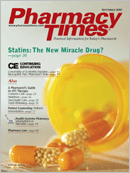Publication
Article
Pharmacy Times
RxPRODUCT NEWS: PROFILE: DepoDur (morphine sulfate extended-release liposome injection)
Author(s):
Although several techniques areavailable to control postoperativepain, these options can becostly and inconvenient and oftenresult in low patient satisfaction.1,2 In2004, the FDA approved DepoDur, anextended-release liposomal formulationof morphine sulfate. Marketed byEndo Pharmacuticals Inc and developedby SkyePharma, DepoDur isadministered epidurally at the lumbarlevel and is indicated for the treatmentof pain following major surgery,including hip replacement, lowerabdominal, and elective cesarean sectionsurgery.3
Pharmacology
DepoDur is an opiate agonist,specifically at the receptor.4 At highdoses, it may interact with other opiatereceptors.4 Resembling opioids likeenkephalins and endorphins, Depo-Dur produces analgesia in the centralnervous system.5
Clinical Trials
A randomized, double-blind, placebo-controlled, parallel-group, doserangingstudy compared single epiduraldoses of DepoDur (15, 20, and 25mg) versus placebo in patients undergoinghip arthroplasty. The 194patients who underwent surgerywere able to self-administer intravenousfentanyl for breakthroughpain. Results demonstrated that allDepoDur doses significantlydelayed the time to the first dose offentanyl and reduced fentanyladministration versus placebo (P <.0001). Postoperative pain control(48 hours postdose) had also improvedin all DepoDur groups versus placebo(P < .0005).5
Another similarly designed studyinvolved approximately 500 patientsundergoing lower abdominal surgery.The trial compared 6 different treatmentsfor postoperative pain for up to48 hours, such as single epidural dosesof DepoDur 10, 15, 20, and 25 mg, single-dose DepoDur 5 mg, and standardepidural morphine sulfate 5 mg. Adose-response relationship betweenthe DepoDur doses and postsurgicalPCA fentanyl use for breakthroughpain was also established 48 hoursafter the procedure. Results revealedthat patients using 10, 20, and 25 mgDepoDur used significantly less fentanylversus DepoDur 5 mg (P = .0446,P = .0221, and P = .0001, respectively).Moreover, the DepoDur 10-, 15-, 20-,and 25-mg groups obtained significantlylower pain intensity scores andgreater pain relief.1
Safety
DepoDur is an effective option forthose who may have impaired hepaticor renal function. This is attributed toless morphine metabolite accumulationbecause of single-dose administration.4 DepoDur is contraindicated inpatients with known morphine hypersensitivity,respiratory depression,acute or severe bronchial asthma,upper airway obstruction, paralyticileus, head injury, or increasedintracranial pressure. Common adverseevents include hypotension, urinaryretention, nausea, vomiting, constipation,pruritus, pyrexia, anemia,headache, and dizziness. Respiratorydepression is a severe side effect andcan occur at high doses.6 DepoDurshould not be substituted for othermorphine products, since its liposomalformulation allows for extendedrelease for up to 48 hours.4
Outlook
DepoDur is available in 10-mg/mL,15/1.5-mg/mL, and 20/2-mg/mL preservative-free, single-use, amber vialsand must be refrigerated. DepoDur is aSchedule II controlled substance, soaddiction and diversion could presentproblems, but these concerns shouldnot deter proper postoperative painmanagement.4 DepoDur appears to bean effective option for the treatmentof pain in postsurgical patients.
Drs. Faria and Soo are both senior researchpharmacists with the Investigational DrugService at Brigham and Women's Hospital,Boston, Mass. Dr. Faria also is a seniorhuman research specialist at PartnersHealthCare System. Diem Chi Tran is asixth-year PharmD candidate from theMassachusetts College of Pharmacycurrently on clinical clerkship in theInvestigational Drug Service at Brigham andWomen's Hospital.
For a list of references, send astamped, self-addressed envelope to:References Department, Attn. A. Stahl,Pharmacy Times, 241 Forsgate Drive,Jamesburg, NJ 08831; or send an e-mailrequest to: astahl@ascendmedia.com.







